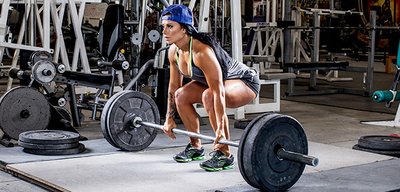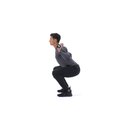The phrase "Starting Strength" (SS) has two distinct meanings:
- The first is the title of the best-selling book, "Starting Strength: Basic Barbell Training," 3rd edition, by Mark Rippetoe.
- The second is the Starting Strength Novice Program (aka the "Starting Strength Linear Progression").
Program Overview
While the program appears in the book, the book itself is much more than simply a description of the Starting Strength program. "Starting Strength: Basic Barbell Training" provides an in-depth, thorough analysis of the five primary barbell lifts: squat, deadlift, press, bench press, and power clean/power snatch.
Correct form is derived through analysis and application of functional anatomy, biomechanics, and physics. How to utilize this correct form is then distilled into easy-to-follow instructions that make the complexities of the lifts as easy to execute as possible.

{{caption}}
This guide focuses more on the program aspect of Starting Strength. There is no substitute or shorthand method to convey the analysis, model, and method found in the book. "Starting Strength" is the only work of its kind. No other resource delves as seriously and deeply into the background and application of technique for the primary barbell lifts and how to correct deviations from proper technique.
Doing the Starting Strength Program without using the Starting Strength Lifting Model and Method will work, but not nearly as well as using both together. It is therefore highly recommended that you purchase and read the book before beginning the Starting Strength Program.
Why Do Starting Strength?
The Starting Strength Program is the best program for a novice to develop the strength that will serve as the basis for all future training, as well as increase performance in life and sports. Developed by Mark Rippetoe and refined over decades of experience coaching thousands of trainees, the Starting Strength Program allows trainees to make faster strength gains during their first serious period of training than any other program.

{{caption}}
The Starting Strength Program is an appropriate place to start for nearly all trainees new to serious strength training. Whether the long-term goal is powerlifting, general health and fitness, or training for sport, the program will provide the training base necessary to succeed and excel at any and all of those endeavors.
The Starting Strength Program's beauty is its simplicity. You need only perform and master five basic barbell exercises, plus chin-ups, to complete this program. It is cost-effective for those who prefer to purchase their own equipment and work out at home. It is also time-efficient, since you don't need to perform a lot of isolation or assistance work.
With that introduction, let's get to the actual program.
Starting Strength: General Notes
The Starting Strength Program can be broken down into two workout days: Day A and Day B.
The entire body is worked each session. As the trainee progresses through the program, Days A and B are slightly modified to take into account the adaptations in the body of the lifter.
The goal of this program is to add weight each and every time you lift, taking advantage of The Novice Effect that allows you to do so. Perform the program 3 days per week, on non-consecutive days (e.g., Monday/Wednesday/Friday, Tuesday/Thursday/Saturday).
Most healthy men between the ages of 18 and 35 can add 10 pounds to the squat the first 2-3 times it's performed, 15-20 pounds to the deadlift the first couple times, and 10 pounds the next several times it's performed. After that, jumps become 5 pounds per workout. For the press, bench press, and power clean, you may get one 10-pound jump, but you may need to start with 5-pound jumps. Later on, you'll move to 2.5 pound jumps or smaller for these lifts when 5 pounds becomes too much to add every workout.

{{caption}}
Most women (and men over 35) will begin with smaller jumps—perhaps a single 10-pound jump in the squat, two or three 10-pound jumps in the deadlift, and immediate 5-pound jumps in the other exercises—then proceed to 2.5 pounds or smaller incremental increases in some movements sooner.
Once you're into Phase 3 and doing chin-ups as part of the program, some of you will progress to weighted chin-ups. If you can perform 3 sets of 10 reps at bodyweight, then you can do every other chin-up workout as a 3 sets of 5 weighted, while continuing to do 3 sets of bodyweight chins to fatigue on your alternate chin-up days.
Now let's get to the program itself.
Phase 1
(Usually 1-3 weeks)

BodyFit
$6.99/month- 2,500+ expert-created single workouts
- 3,500+ how-to exercise videos
- Detailed workout instruction
- Step-by-step workout tips
- Training at gym or at home
- Access to Workout Plans
- Access to Bodyfit App
- Store Discounts
Already have a Bodybuilding.com account with BodyFit? Sign In

What comes with BodyFit?

- Instructional Videos
Don't risk doing a workout improperly! Avoid injury and keep your form in check with in-depth instructional videos.

- How-to Images
View our enormous library of workout photos and see exactly how each exercise should be done before you give it a shot.

- Step-by-Step Instructions
Quickly read through our step-by-step directions to ensure you're doing each workout correctly the first time, every time.

BodyFit
$6.99/month- 2,500+ expert-created single workouts
- 3,500+ how-to exercise videos
- Detailed workout instruction
- Step-by-step workout tips
- Training at gym or at home
- Access to Workout Plans
- Access to Bodyfit App
- Store Discounts
Already have a Bodybuilding.com account with BodyFit? Sign In

What comes with BodyFit?

- Instructional Videos
Don't risk doing a workout improperly! Avoid injury and keep your form in check with in-depth instructional videos.

- How-to Images
View our enormous library of workout photos and see exactly how each exercise should be done before you give it a shot.

- Step-by-Step Instructions
Quickly read through our step-by-step directions to ensure you're doing each workout correctly the first time, every time.
Phase 1 Notes
In this initial phase, workouts A and B are the same, except that the press and bench press alternate. So if you began the program on Monday and pressed, you'll bench press Wednesday and press again Friday. The second week, you'll bench press Monday and Friday and press on Wednesday.
At the end of this phase, if you're in that 18-35 healthy male demographic, your squat should have increased by 40-50 pounds, your deadlift by 50-70 pounds, and your press and bench press by 15-20 pounds.
There is no single prescription for everyone, so common sense and paying attention to how your body responds to the increased weight are your best guides.

{{caption}}
Phase 2

BodyFit
$6.99/month- 2,500+ expert-created single workouts
- 3,500+ how-to exercise videos
- Detailed workout instruction
- Step-by-step workout tips
- Training at gym or at home
- Access to Workout Plans
- Access to Bodyfit App
- Store Discounts
Already have a Bodybuilding.com account with BodyFit? Sign In

What comes with BodyFit?

- Instructional Videos
Don't risk doing a workout improperly! Avoid injury and keep your form in check with in-depth instructional videos.

- How-to Images
View our enormous library of workout photos and see exactly how each exercise should be done before you give it a shot.

- Step-by-Step Instructions
Quickly read through our step-by-step directions to ensure you're doing each workout correctly the first time, every time.

BodyFit
$6.99/month- 2,500+ expert-created single workouts
- 3,500+ how-to exercise videos
- Detailed workout instruction
- Step-by-step workout tips
- Training at gym or at home
- Access to Workout Plans
- Access to Bodyfit App
- Store Discounts
Already have a Bodybuilding.com account with BodyFit? Sign In

What comes with BodyFit?

- Instructional Videos
Don't risk doing a workout improperly! Avoid injury and keep your form in check with in-depth instructional videos.

- How-to Images
View our enormous library of workout photos and see exactly how each exercise should be done before you give it a shot.

- Step-by-Step Instructions
Quickly read through our step-by-step directions to ensure you're doing each workout correctly the first time, every time.
Phase 2 Notes
In this phase, we introduce the power clean. Your deadlift is now heavy enough that doing it 3 days per week is difficult to recover from. You'll do deadlifts on Day A as before, and do 5 sets of 3 reps in the power clean on Day B. The explosive nature of the power clean will continue to help drive up your deadlift, without the excessive fatigue associated with high-frequency deadlifting.
The length of Phase 2 can be varied from several weeks to several months, depending on the individual trainee.
Phase 3

BodyFit
$6.99/month- 2,500+ expert-created single workouts
- 3,500+ how-to exercise videos
- Detailed workout instruction
- Step-by-step workout tips
- Training at gym or at home
- Access to Workout Plans
- Access to Bodyfit App
- Store Discounts
Already have a Bodybuilding.com account with BodyFit? Sign In

What comes with BodyFit?

- Instructional Videos
Don't risk doing a workout improperly! Avoid injury and keep your form in check with in-depth instructional videos.

- How-to Images
View our enormous library of workout photos and see exactly how each exercise should be done before you give it a shot.

- Step-by-Step Instructions
Quickly read through our step-by-step directions to ensure you're doing each workout correctly the first time, every time.

BodyFit
$6.99/month- 2,500+ expert-created single workouts
- 3,500+ how-to exercise videos
- Detailed workout instruction
- Step-by-step workout tips
- Training at gym or at home
- Access to Workout Plans
- Access to Bodyfit App
- Store Discounts
Already have a Bodybuilding.com account with BodyFit? Sign In

What comes with BodyFit?

- Instructional Videos
Don't risk doing a workout improperly! Avoid injury and keep your form in check with in-depth instructional videos.

- How-to Images
View our enormous library of workout photos and see exactly how each exercise should be done before you give it a shot.

- Step-by-Step Instructions
Quickly read through our step-by-step directions to ensure you're doing each workout correctly the first time, every time.
Phase 3 Notes
At this point you've become strong enough to pull enough weight that we limit deadlift and cleaning frequency. Each is alternated on Day A, while chin-ups are performed on Day B. So if you deadlift on Monday, you'll do chins on Wednesday, power cleans Friday, chins (or weighted chins, see General Notes above) on Monday, and deadlift again Wednesday. This allows adequate recovery.
Phase 3 is also often where people often need to begin micro-load their pressing movements and cleans, adding weight in 2.5 pounds or smaller increments to continue linear progress.
Finally, Phase 3 is also often where people reach the "Advanced Novice" stage, and add weight to their squats only twice per week (e.g. Monday and Friday), while using Wednesday as a lighter recovery day for squats.

{{caption}}
Frequently Asked Questions
Warm-up Sets
People get confused here, but it's not rocket science. Take the difference between the empty bar and your working weight, and make four relatively even jumps between the two.
For example, if your work sets will be at 275 pounds:
- Empty bar (45 lbs) × 5 reps × 2 sets
- 135 × 5
- 185 × 3
- 235 × 2
- 275 × 5 × 3 (5 reps, 3 sets)
If your working weight will be 95 pounds:
- Empty bar (45 lbs) × 5 reps × 2 sets
- 60 × 5
- 75 × 3
- 85 × 2
- 95 × 5 × 3
And so on.
If you'd rather just not think about it, you can get the Starting Strength Warm-up App for iPhone or Android.
Stalling
When you don't make the prescribed sets and reps in a given exercise, try again the next time that exercise comes up. If you make the lift, continue progressing. If you miss again, deload your weight in that lift by 8-10 percent, and work your way back up from there, using small jumps.
If you do two or three deloads, work back up, and stall again, you're probably done with your linear progression for that particular exercise, assuming that your sleep and nutrition have been in order.
Recovery
Sleeping less than 7-8 hours per night will negatively affect your recovery. If you are short on sleep on a regular basis, the length of time during which you can add weight to the bar as a novice will be artificially stunted.

{{caption}}
Much has been written regarding the optimal nutritional intake to take advantage of the Starting Strength Program. Rip's article, "A Clarification," should be read before beginning the program.
In short, you need to eat enough to recover. Ample protein, carbohydrates, and fat are required. Trying to do this program while on any type of restricted diet is not optimal: intermittent fasting, paleo, and The Zone are examples of three currently popular styles of eating that will stunt your Starting Strength Novice gains.
We don't recommend getting fat while doing the program, but to optimize your gains, you'll probably have to eat a lot more than you're used to. Many underweight young men have supplemented their eating with a gallon of milk a day, the famous GOMAD protocol, to aid in their quest for strength.
If you're already obese, then don't drink the milk, and watch your carbs more carefully, especially if you don't see some weight loss and fat loss over the first few weeks.
Exercises in the Program
A few sets of arm work on Friday is probably OK, and you're probably going to do it anyway, but beyond that, just do the program.
No, you didn't miss anything. There are only six exercises in the program. Adding weight to the bar and progressing on these six exercises will do more for your training than anything else, during your first months. Don't spoil the recipe by adding extra ingredients. A few sets of arm work on Friday is probably OK, and you're probably going to do it anyway, but beyond that, just do the program.
When you have accumulated enough strength and lifting experience to be an intermediate lifter, you'll know enough to decide whether or not to work your reverse leaping axe choppers into the program and if so, how. Until then, just do the program.
One last note: There is much confusion about barbell rows. The program includes power cleans. Substituting barbell rows for power cleans, or power snatches if you can't rack the clean, is not doing the program. There is a very small percentage of people for whom this may be a good idea, but you're almost certainly not one of them.
Do the cleans. If you really think you may be one of those few people, seek out a Starting Strength Coach in your area for a session.
Other Questions
We've tried to be thorough in this guide, but doubtless many of you have more questions. The source texts, "Starting Strength" and "Practical Programming" will answer the vast majority of these questions. The "Starting Strength" DVD provides 2-1/2 hours of examples of practical instruction and form corrections on the basic barbell lifts that are part of this program. It is a useful learning tool for all, especially visual learners.
Attending a Starting Strength Seminar is also highly recommended for those who want to truly master the material. Mean Old Mr. Gravity discusses many of the questions you probably have, organized by topic from previous forum Q&As.
We are also active on Facebook and Twitter. Additionally, Rip provides articles and interviews on Strength & Conditioning on the Starting Strength website and answers questions daily (yes, for free!) on his Mark Rippetoe Q&A.
This article originally appeared on Fitocracy and has been reposted here with permission. It was written by Michael Wolf, a NSCA and USAW-certified strength coach with a deep knowledge of Rippetoe's Starting Strength program.




